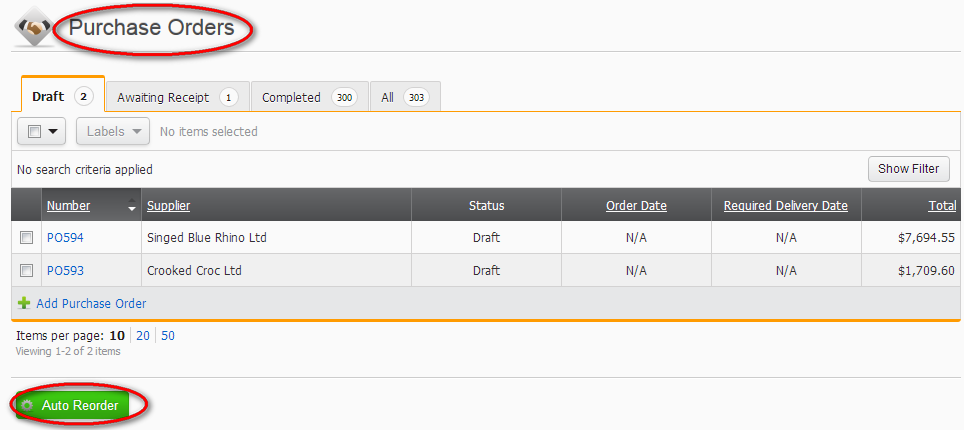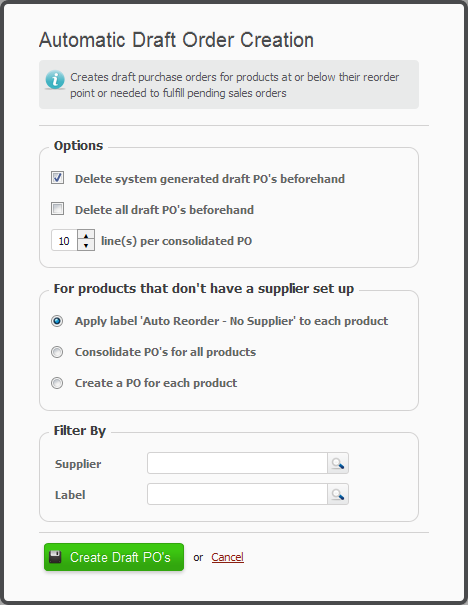You can replenish your low stock with the press of a button. The magic Auto Reorder button can be found at the bottom of the Purchase Orders screen.
Auto reordering will create new draft purchase orders for each product that has fallen below its minimum stock level. Auto reorder will only run when it's convenient for you and when you tell it to, by selecting the Auto reorder button. When assessing which products have dropped below their stock levels and need reordering, any pending sales orders, pending shipments and still to be received purchase orders will be included in the calculations.
 When we auto reorder we will try to get your stock levels back to at least the minimum stock level you defined on your products. Taking into account any current sales orders and unreceived purchase orders.
When we auto reorder we will try to get your stock levels back to at least the minimum stock level you defined on your products. Taking into account any current sales orders and unreceived purchase orders.
Auto reorder works best if you have already configured each product with the suppliers for the product and the reorder quantities etc. This way, when we run auto reorder, we can create new draft purchase orders with your supplier details filled in. When a supplier is unknown for a product, then the creation of the new draft purchase orders gets a bit trickier. That's when the Auto Reorder configuration dialogue becomes useful.
All draft purchase orders created when running the auto reorder will be created for the default primary warehouse, regardless of whether you have multiple warehouses. All products displayed on the purchase order will be ordered by the product code.
Selecting the Auto Reorder button will present a dialogue where you can configure the auto reorder process.
Configuring your auto reordering
Options
Auto reordering offers a plethora of options to best suit your needs. Essentially we need to know, what do you want to do with all the existing draft purchase orders. Do you want to only delete the purchase orders which were created the last time (system generated) auto reorder was run or do you want to delete all purchase orders?
When the suppliers of the products have not been defined, we can create new purchase orders, but how many product lines would you like on these purchase orders, since they won't have a suppliers name on the purchase order. If all your products tend to come from an array of suppliers, then you are more likely to opt to limit the number of lines on the purchase orders to one, so that a single purchase order will be created for each product. You can then fill in the suppliers name etc when you open the newly created draft purchase orders yourself. You can save yourself a lot of time, if you have already configured the preferred supplier for each product.
When the supplier is unknown, you can opt to either bypass the creation of new purchase orders and just flag all the products that are down on their stock levels with an Auto Reorder – No Supplier label or you can opt to create new purchase orders, but with no specified supplier. The label option also allows you the opportunity to update and check your products, before coming back and running auto reorder for real. Because you can rerun the auto reorder at any time and it can be configured to delete all the existing draft purchase orders, you can essentially use it to do a test run of your new purchase orders each time.

In the Options section, you can define which type of existing draft purchase orders to delete before we create the new purchase orders. Delete either the current batch of purchase orders which were created using auto reorder (system generated) or just delete all purchase orders, including the ones you created yourself.
Use the lines(s) per consolidated PO field to set the maximum number of product lines on each draft purchase order. You might prefer a single product on each purchase order, so you would set this to one.
Products missing suppliers
Most of us are human, so it's likely that we forgot to set up some of the suppliers associated with each product. In this case use the For products that don't have a supplier set up section to tell us whether you just want to tag those products with a label or consolidate the purchase orders using the lines(s) per consolidated PO product lines limit or just a create a new purchase order with a solitary product line on it.
We recommend using the label option the first time you run auto reorder, so you can find and rectify the products with the missing suppliers. Plus check the minimum stock levels.
Be aware that products with inventory tracking off and a default minimum stock of zero will also be flagged, if they don't have a supplier defined.
Filter By
You can use the Filter By section to restrict the creation of any new purchase orders by filtering on a solitary supplier and/or a solitary product label.
Reorder quantities
We use the Order Multiple Qty you set against the supplier you associated with the product. If your supplier only allows you to buy in packs of 6, then you can tell us to reorder in multiples of 6, using the Order Multiple value. Most of the time you will probably order in quantities of one and your Order Multiple will be one.
If you have specified more than one supplier against a product we will use the supplier, who was flagged as the preferred supplier. If there is only one supplier for the product then they will be the preferred supplier.
Purchase orders created for unknown suppliers will be created with a default product quantity of one and the supplier name will be blank.
On top of this we will try to get your stock levels back to at least each product's minimum stock level.
The calculation can be broken into two parts. Firstly calculate how much below our minimum stock levels we are. So a basic overview of the formula's is:
Minimum Stock – (Warehouse stock – Sales Orders) – Purchase Orders
Secondly, if that calculation was greater than zero, then it means we need to order more stock:
((Minimum Stock – (Warehouse stock – Sales Orders) – Purchase Orders) / Order Multiple) x Order Multiple
A more precise understanding of the calculation sums the available to ship quantities for each warehouse that is enabled and is also enabled for shipments. This is known as the Available to Ship quantity. The sales orders calculation also sums all the open sales orders and adds in the awaiting pack shipments. The purchase order calculation includes all open purchase orders including draft purchase orders. So the precise calculation is:
Order Multiple x CEILING(Minimum stock – (the Available to Ship stock – all open sales orders + all awaiting pack shipments) – all open purchase orders) / Order Multiple
If the quantity to reorder is greater than zero, then the product will be added to a Draft purchase order when Auto Reorder is run.
Examples
Example 1
We are low on stock, have several sales orders to fulfill, an outstanding purchase order and an order multiple requirement of 8.
In stock = 10
Minimum stock level = 30 (with an order multiple quantity of 8)
Unfulfilled sales orders = 7
Unreceived purchase orders = 4
So for starters we have a re-order quantity of
30 – (10 – 7) – 4 = 23
Since 23 is greater than zero, it means we need to order more stock. However, our Order Multiple of 8 doesn't fit neatly into 23, so we have to go to the next multiple of 8 above 23, which is 24. Running auto reorder would create a draft purchase order for 24.
You could use the Order Multiple quantity to define a minimum purchase order quantity. Just be aware that this won't necessarily be your minimum stock, plus the Order Multiple quantity. As highlighted in the example above, which only gave us 1 more, not 8 more than our minimum stock level.
Example 2
We have sales orders for more stock than we can supply and the supplier requires us to order in multiples of 6. There are no current purchase orders for the product.
Our product has a minimum stock of 12. We don't have any purchase orders. We have sales orders with a total quantity of 10 that we have not supplied, because we have run out of stock. The Order Multiple quantity on the product is 6.
Our available to ship stock is 12 below our minimum stock. We have outstanding sales orders for 10, so we are looking for at least 22, just to get back to the minimum stock level. However, our Order Multiple of 6 doesn't fit neatly into 22, so we have to go to the next multiple of 6 above 22, which is 24. Running auto reorder would create a draft purchase order for 24.
You could use the Order Multiple quantity to define a minimum purchase order quantity. Just be aware that this won't necessarily be your minimum stock plus the Order Multiple quantity. As highlighted in the example above, which only gave us 2 more, not 6 more than our minimum stock level.
Example 3
We have run out of stock and there is already a purchase order in the system to replenish some of the stock.
Our product has a minimum stock of 20. We have an existing purchase order with a quantity of 12 that has not yet been received. We have supplied all our outstanding sales orders and have no stock left. The Order Multiple quantity on the product is 1.
So our stock is down by 20, but we already have an existing purchase order for 12, so we are looking for 8 more to get our stock back to the minimum stock.